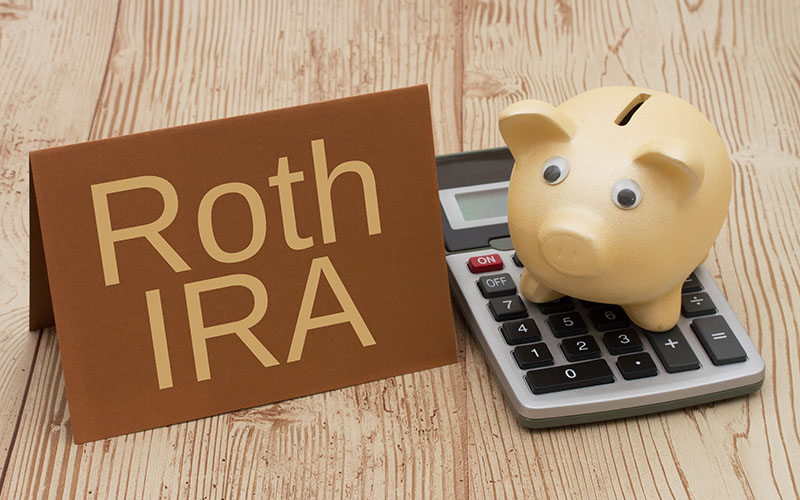What Is A Roth IRA?
Key Takeaways
- Roth IRAs offer tax-free withdrawals in retirement, making them ideal if you expect to be in a higher tax bracket later
- You pay taxes upfront on contributions, but your money grows and can be withdrawn tax-free after age 59½ (if conditions are met)
- No required minimum distributions (RMDs) mean more flexibility in how and when you use your funds
- You can contribute at any age as long as you have earned income and meet income limits
- Roth IRAs offer flexibility for emergencies, education, and even home purchases—plus they’re a useful legacy planning tool

When it comes to saving for retirement, it can be difficult to know which route is best for you: a 401(k), traditional IRA, or a Roth IRA. Below, we break down everything you need to know about a Roth IRA -- and how it compares to your other options.

What is a Roth IRA?
A Roth IRA is a retirement account that allows you to have tax-free growth on your investments. While this account requires you to pay taxes on your initial contribution (meaning you don't get to take a deduction like with other retirement accounts), you will be able to grow your funds and withdraw them at retirement tax-free.
While IRA's do have eligibility requirements and specific stipulations, it can end up being incredibly important when you retire.
You can open a Roth IRA anytime, regardless of your age, as long as you have earned income to contribute. However, you can't contribute more than the amount earned.
How Does It Work?
A Roth IRA is a great way to kickstart your retirement savings. Even if you have a 401(k), a Roth IRA has major benefits. While you pay taxes on your Roth IRA contributions, you can withdraw your earnings completely tax-free.
Additionally, a Roth IRA holds your investments rather than being the investment itself. When you open your Roth IRA, you decide what you want to invest in:
- A low-risk Certificate of Deposit (CD)
- Individual stocks
- Bonds
- Mutual funds
- Bank savings products
- Exchange-traded funds (ETFs), which are similar to mutual funds and track an index but have a lower annual cost.
- Options
- Real estate
- Target-date funds, which allow you to pick the year you want to retire and automatically balances from higher-risk to lower-risk investments the closer you get to retirement.
Below, we look at the other uses and benefits of a Roth IRA.
The Benefits of a Roth IRA
- Roth IRAs are a great option for retirement savings account if you anticipate a higher tax rate in the future since you are paying an income tax on your funds before you contribute it to your account. Essentially, it offers you lower taxes at retirement.
- You can begin to make tax-free withdrawals on your funds when you have reached 59½ (or in the case of death, disability, or $10,000 of qualified first-time home purchase expenses) and have had your account open for at least five years.
- Unlike a 401(k) or a traditional IRA, you are not subjected to required minimum distributions (RMDs) once you reach 70½, meaning you are not required to withdraw your funds, you have a choice in how to spend your money, and any funds still in your Roth IRA can continue to grow tax-free.
- You can contribute earned income to a Roth IRA at any age, as long as you don't make too much. (If you do make too much money, you can utilize a Backdoor Roth IRA to get around this.) Unlike a traditional IRA, you can contribute to a Roth IRA after the age of 70½.
- You can use your funds for certain educational expenses, such as paying for college tuition or as an alternative to a 529 plan. While the penalty is waived, you may still have to pay income taxes on early distributions -- even if those are qualified costs.
- You can use a Roth IRA to pass money to your children and other descendants.
- A Roth IRA can be set up for minors who have earned their income.
- A Roth IRA gives you access to your initial contributions when you make investments without paying any income taxes or penalties. This flexibility allows consumers to access their funds in the case of an emergency.
- Roth IRAs are particularly useful for millennials (individuals born between 1981 and 1996), primarily because most millennials pay a lower tax rate now than they will at retirement. A Roth IRA can assist younger individuals by allowing them to use it for education expenses or to buy, build, or improve a home (up to $10,000).
- You can contribute to a Roth IRA until the tax filing deadline in the following year, meaning the amount you contribute can still count for the following year.

Where to Open a Roth IRA
Setting up a Roth IRA is simple and can be done in a matter of minutes through a brokerage, bank, or credit union (such as Vanguard, Fidelity, an online broker, or with the assistance of a financial advisor).
Compare your options to make sure you are receiving low fees and best options. Specifically, look for mutual funds with no transaction fees and commission-free ETFs since these extra costs can add up in the long run.
You will also want to look for a service that allows you to rollover other accounts (such as a 401(k) or traditional IRA) into your Roth IRA. After all, if you leave a job that offered a 401(k), you will want to ensure that you can keep the amount you've accrued.
Something to keep in mind: there are limits to opening or contributing to an IRA.
- You won't be eligible for a Roth IRA if you earn too much annually
- The amount you can contribute to a Roth IRA decreases as your income increases -- and if you reach a certain threshold, you may not be able to contribute at all.
- For married couples in which one spouse isn't working, the non-employed spouse can still contribute to an IRA as long as the total contributions don't exceed the total annual income.
To learn more about limits and contributions, visit the official Roth IRA site.
How much can I contribute to a Roth IRA in 2019?
If you are under 50, you can contribute $6,000 per year (note: this depends on your gross annual income).
Can I lose money in a Roth IRA?
Yes. While a Roth IRA is a great investment for retirement, it carries more of a risk of losing money than other savings accounts like Certificates of Deposit.
Should I invest in a Roth IRA or 401(k)?
If you can contribute to both, then you certainly should -- they are both important retirement savings plans.
As long as your employer offers to match your 401(k) contribution, you should always utilize that without fail.
However, if your 401(k) is expensive or lacks worthy investments, it may be better for you to max out your traditional IRA or your Roth IRA.
Additionally, a traditional IRA and 401(k) offers you a tax break incentive in the beginning by allowing you to pay taxes on your funds before putting it in your account to grow until you eventually pay income taxes on your contributions when you pull out your funds. Meanwhile, a Roth IRA and a Roth 401(k) allow you to grow your funds after you have already paid income tax on it.
What is the difference between a traditional IRA and a Roth IRA?
The main difference between a traditional IRA and a Roth IRA is when you pay your taxes. A traditional IRA allows you to make contributions without paying taxes initially; however, when you withdraw your funds at retirement, you will have to pay taxes on the full amount. A Roth IRA requires you to pay taxes upfront but allows you to grow and eventually withdraw your funds tax-free.
Can I transfer my 401(k) to a Roth IRA?
Yes, but unless you move it to a Roth 401(k), you will probably wind up owing income tax on the full amount. It may also move you up to a higher tax bracket, resulting in a greater payment on your taxes.
What are some disadvantages of a Roth IRA?
The biggest disadvantage is that if you withdraw before age 59½, you will have to pay a 10% penalty unless you meet one of the exemptions.
Additionally, if you earn too much in a specific year, you may not be allowed to contribute to your Roth IRA that year.
Edited by:
Bryan Huynh
•
Product Tester & Writer








